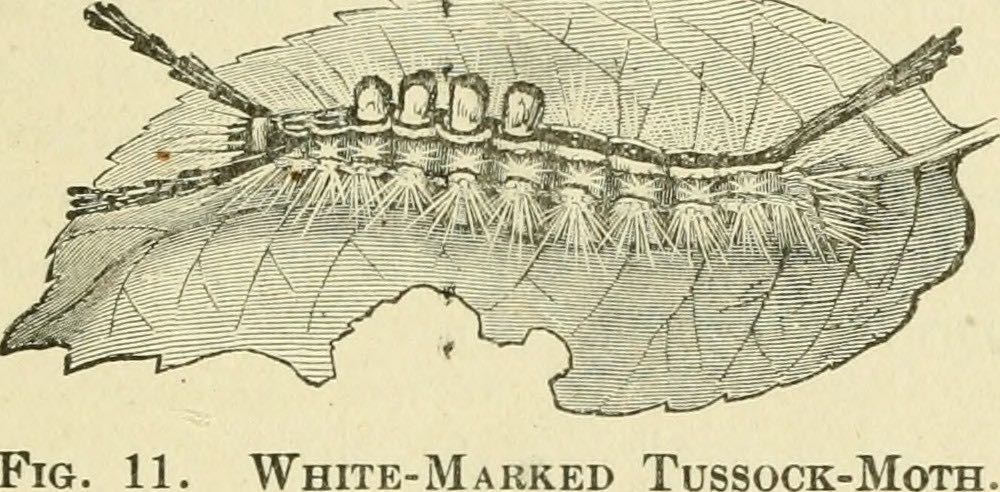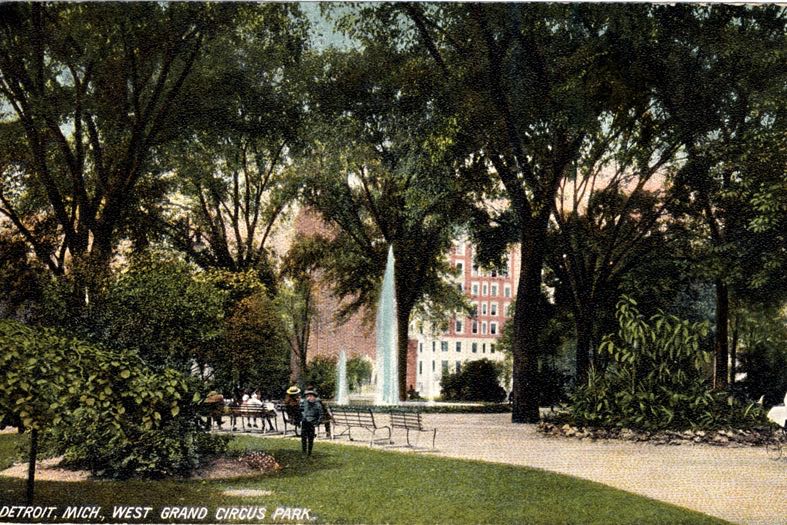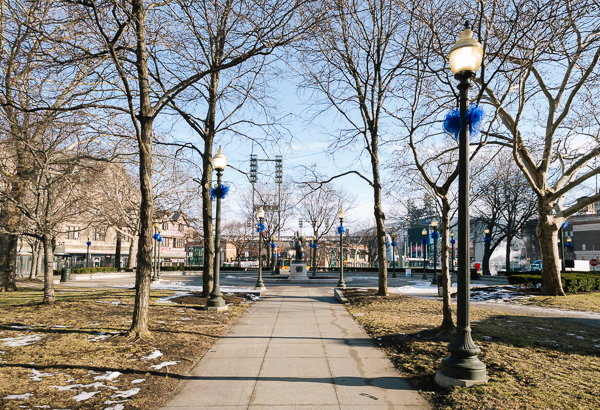Detroit's tree-lined streets were first imagined by the man who planned the streets themselves: Territorial Judge Augustus Woodward.
Inspired by civil engineer Pierre Charles L'Enfant, who planned Washington D.C. in 1791, Woodward designed a city of broad avenues and moon-shaped parks. His plan called for the widest boulevards to be tree-lined in the Parisian fashion. Woodward, a weird but visionary guy, looked at a muddy, burned-out village of 800 farmers and created a plan fit for a city 100 times larger and grander, on the scale of the great new seat of American democracy. Though it was never fully implemented, the Woodward Plan gave Detroit a foundation of continental flair — wide streets perfectly suited for a canopy of gracefully arching shade trees.
Trees can be both beneficial to an urban environment — providing shade and coolness, cleaning the air, and creating compelling beauty — and a nuisance. Trees destroy and are destroyed by a city. In Detroit, their roots backed up sewers and tore up sidewalks. They were cut off or cut down to make way for expanding streets and rising buildings. Horses gnawed on them. It took almost a century after the Woodward Plan for Detroit to figure out who was supposed to plant them, treat them when they were sick, remove them when they were dead, and how much the whole operation should cost.
But through decades of trial and error, frustration and foible, Detroit earned a reputation for urban loveliness and boasted one of the country's most robust and innovative forestry divisions. The city that put the world on wheels was also — famously, if somewhat accidentally — a city of trees.
Why don't we figure out whose job this is?
Alex Dow — the engineer who introduced Henry Ford and Thomas Edison — had a problem with Detroit's street trees. There were too many of them. And they were a serious impediment to his public lighting plan.
"If the residents of this city would care for their trees as they ought to be cared for there would be little trouble, but they simply stick up a sapling and let it grow as it wants, and the result is a stubby stem with a spreading sponge of foliage at the top," he said in an 1895 interview with the Detroit Free Press. "Then about twice as many trees are set out as are really needed. They are so close together as to shut out all light, whether of the sun or of the electric lamps." Dow declared that if he were in charge, he would have all the trees cut down, but he was smart enough to instead suggest an ordinance regulating the city's street trees and putting them under the care of a forester.
Dow was hardly the first person to appreciate the potential problems of unregulated tree growth —
Detroit had tried, and failed, to address street tree maintenance since at least the 1850s.
But with the city rapidly modernizing and
its population booming over 100,000 in the 1890s, trees were in the way of urban improvements such as telephone wires, paving projects, and street lamps. The lack of clear rules on how to manage the treescape finally became a problem.
Meanwhile, another issue was raising its head: how to deal with insect infestations, in particular the tussock moth, which threatened the health of the city's entire tree population.

The caterpillar of the white-marked tussock moth eats the leaves of all kinds of common city trees, including elms, maples, oaks, and chestnuts. They're a tree pest even today, but were particularly virulent in Detroit and across the country in the 1900s and 1910s. (To mitigate a tussock moth outbreak, some cities even hired school kids to go pluck eggs off the trees in exchange for a small per-egg fee.)
An apocalyptic op-ed in the Free Press in 1906 suggested that without a street tree ordinance, "T
here is now a danger that neglect and indifference will find their logical product in the destruction of the urban forest."
So it happened that the tiny tussock moth caterpillar — a beautiful caterpillar, everyone agreed, with a little red cap on its head and blonde spines — finally spurred the city to action on creating a plan for its street trees.
The parks department gets it done
A city commission for Detroit's parks was first created in 1854, the same year that Grand Circus Park — part of Judge Woodward's original plan — officially became a city park. (Before then, both sides of Grand Circus Park were "ponds and marshes, enlivened only by the music of the bullfrog, and used as a place of deposit of refuse of every kind," wrote Silas Farmer.) The commission was responsible for planting trees in the city's green spaces, for which they had a modest budget. Most city parks remained fenced off and closed to the public until the mid-1860s, ostensibly to let newly-planted trees grow undisturbed, though the commission didn't have resources for parks staff or grounds maintenance either.
 Grand Circus Park, 1909
Grand Circus Park, 1909
From 1870 to 1900, the city added about 1300 acres to its park system with the acquisition of Belle Isle in 1879 (purchased by the city after a years-long controversy dubbed"The Park Question" by exhausted reporters), Clark Park in 1888 (left to the city in the will of John Pearson Clark, on the condition that the native timber on the land should remain — and, curiously, that a beaver dam on the property should be left alone in its natural state, "subject only to the action of time"), and Palmer Park in 1893 (a gift to the city from Senator Thomas Palmer, which included 90 acres of virgin forest as well as Palmer's log cabin, a famed site of folksy parties in its day).
More parks meant a bigger and pricier parks department, and thousands more trees for the city to take care of. In 1900, to reduce costs, the city started a nursery for growing its own trees, shrubs, and flowers. It was one of the first municipally-owned nurseries in the country, and over time it took on a secondary goal of becoming a kind of arboretum of native Michigan tree species. To care for the nursery, the city employed a forester, Harry J. Hunter.
Detroit's street trees remained under the care of a different city department, the Board of Public Works, which was responsible for its own massive tree-planting projects, including the Grand Boulevard, a Haussman-inspired beautification project that broke ground in 1891. Grand Boulevard, which encircled what were then the outer limits of the city, was planted with showy flower beds and over 6000 trees.
In 1907, Parks Commissioner Philip Breitmeyer proposed that the care of the city's trees be consolidated under his department, seeing as it already had a forester. He blamed poplars and chestnuts — prolific street trees at the time — for the source of the ongoing tussock moth problem, and urgently argued that the pest had the potential to destroy all of the city's trees. Public Works Commissioner J.J. Harrar met this suggestion with apathy. The Parks Department had less to do than his department anyway, Harrar basically said, so why not?
The wheels of bureaucracy turned slowly, but turn they did, and in 1910, the city finally passed a street tree ordinance that gave their care to the parks department and defined the species that were allowed to be planted along the city's streets: elms, several variety of maples, plane trees, white ash, gingkos, linden, and pin oaks. No new poplars or chestnuts were allowed.
While the tussock moth infestation never totally went away, a single department responsible for fighting it was able to more efficiently spend its resources on regular maintenance and prevention, egg removal, and spraying, which over time drastically reduced the impact of pests and disease.
Long story short: it was finally somebody's job.
Predictably, budget constraints
 Grand Circus Park, 2016
Grand Circus Park, 2016
By 1916, Detroit had a full-time forester in its employ and 250,000 street trees in its care. But when the parks department requested $63,000 in appropriations for forestry, it received only $23,000 (about $500,000 today).
Which wasn't nearly enough, the department argued. The city was spending about nine cents per tree in 1916. Philadelphia, with a little over half as many trees — and far fewer trees per person, about one tree per 20 people compared to Detroit's one tree per three people — had nearly the same budget and spent about 16 cents per tree. Washington D.C. spent about 42 cents per tree on its 100,000 street trees. And Paris, the epitome of a "city of trees," spent over a dollar per tree. The department warned that it was losing 5,000 trees a year due to natural death, pest infestation, and disease, and that less than a quarter of those could be replaced.
The historical hustle for forestry resources resonates with Todd Mistor, Detroit's interim superintendent of forestry and ground maintenance.
"We've always known that trees are good — but it's like the arts or music," Mistor says. Despite dozens of studies proving the benefits of trees — lower energy bills, better health and well-being, a more sustainable environment — "when you have to cut funding in something, it's one of the first things to go. We have to stop thinking about it as a nicety."
Despite funding shortfalls, Detroit's forestry division set an example for urban foresters around the country. In 1914, the city was the first to set up a municipal sawmill and turn dead branches and trunks into cordwood, park benches, and cribbage boards. (In 1948, city forester Walter Myers — namesake of the nursery at Rouge Park — said the sawmill was "old" when he arrived at the department 24 years earlier.) The city published a widely-circulated pamphlet of best practices for city trees — ominously, the author cautioned against planting elms as a street tree due to the ravaging effects of the elm-leaf beetle. It hosted the annual conference of American Association of Park Superintendents in 1921, where city forester C.E. Smith hosted a session about forestry in Detroit. And in the 1920s, the city expanded its nursery to its newest, largest park, Rouge Park. The capacious Walter I. Meyers Nursery at Rouge Park was functional in some capacity until at least the 1990s, serving both as a source of tree stock and a site of experimentation. (In 2009, Greening of Detroit and the City of Detroit
announced a partnership to revive the Meyers nursery)
Today, Detroit's tree count is just over 172,000 — still about one tree for every three people, based on the latest Census estimates of about 680,000 residents. The city still has a long way to go, however, toward restoring its canopy to ideal levels after the double devastation of Dutch elm disease and emerald ash borer. Detroit is
not the only city restoring its tree canopy, though, and with any luck, the city's innovative approaches to forestry management and canopy restoration can continue to set an example for the rest of the country's tree-lined streets.
Amy Elliott Bragg is director of content for Model D's parent company, Issue Media Group. She blogs about pre-automotive history in metro Detroit at The Night Train. Follow her on Twitter @thenighttrain.
This story is a part of a statewide Forest Management Community Impact Series edited by Nina Ignaczak. Support for this series is provided by the Michigan Department of Natural Resources.